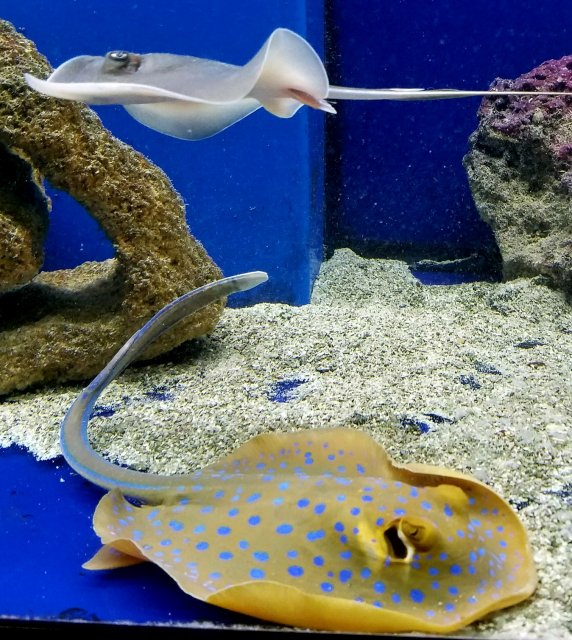So I have seen Atlantic sting rays for sale in fresh water. I know they salt but I am hearing they are blackish and now I am seeing they sold fresh. So I am kind of loss with that situation. I don't know if it's like while they are young they can do fresh and later on have to be turn to blackish or what. I would love some info from someone has kept these and preferably to their adult size. Thanks.
Atlantic Stingrays?
- Thread starter Ozip
- Start date
You are using an out of date browser. It may not display this or other websites correctly.
You should upgrade or use an alternative browser.
You should upgrade or use an alternative browser.
I did a google search.
"This stingray is euryhaline and can maintain adequate physiological functions at varying degrees of salinity. Stingrays found in the St. Johns River system, Florida, represent the only permanent fresh water population of an elasmobranch in North America."
https://www.floridamuseum.ufl.edu/discover-fish/species-profiles/dasyatis-sabina/
"An interesting aspect of the Atlantic Stingray's biology is its ability to handle variations in environmental salinity. In general, elasmobranchs are considered to be stenohaline (salinity restricted) marine species; less than 5% of all elasmobranch species have been found in fresh water. The Atlantic Stingray, however, is a glaring exception. It is often found in estuaries and far up rivers during the warm, summer months. The populations that I am interested in have gone to the extreme by living year round and reproducing in freshwater lakes of the St. Johns River, FL. Although an extensive tag and release program has not been conducted, it is unlikely that these animals are making consistent migrations back and forth between marine and freshwater environments.
Even though it is not likely that the freshwater stingray populations in the St. Johns River migrate to the ocean, they have not lost the physiological ability to do so. I have conducted experiments that demonstrate freshwater D. sabina from Lake Jesup can acclimate to sea water (30 ppt salinity). They are able to do this because even in fresh water their kidneys reabsorb urea. Unlike the stenohaline freshwater South American Stingrays of the family Potamotrygonidae, D. sabina still has the neprhon segment associated with urea retention. So, in essence these animals are "primed" for return to salt water by reabsorbing more urea when faced with a salinity increase."
http://nersp.nerdc.ufl.edu/~pmpie/dsabina.html
"This stingray is euryhaline and can maintain adequate physiological functions at varying degrees of salinity. Stingrays found in the St. Johns River system, Florida, represent the only permanent fresh water population of an elasmobranch in North America."
https://www.floridamuseum.ufl.edu/discover-fish/species-profiles/dasyatis-sabina/
"An interesting aspect of the Atlantic Stingray's biology is its ability to handle variations in environmental salinity. In general, elasmobranchs are considered to be stenohaline (salinity restricted) marine species; less than 5% of all elasmobranch species have been found in fresh water. The Atlantic Stingray, however, is a glaring exception. It is often found in estuaries and far up rivers during the warm, summer months. The populations that I am interested in have gone to the extreme by living year round and reproducing in freshwater lakes of the St. Johns River, FL. Although an extensive tag and release program has not been conducted, it is unlikely that these animals are making consistent migrations back and forth between marine and freshwater environments.
Even though it is not likely that the freshwater stingray populations in the St. Johns River migrate to the ocean, they have not lost the physiological ability to do so. I have conducted experiments that demonstrate freshwater D. sabina from Lake Jesup can acclimate to sea water (30 ppt salinity). They are able to do this because even in fresh water their kidneys reabsorb urea. Unlike the stenohaline freshwater South American Stingrays of the family Potamotrygonidae, D. sabina still has the neprhon segment associated with urea retention. So, in essence these animals are "primed" for return to salt water by reabsorbing more urea when faced with a salinity increase."
http://nersp.nerdc.ufl.edu/~pmpie/dsabina.html
No because once you go blackish you don’t go blackish! Jk Atlantic stingrays are FW but also get massive if I’m correct and they are dull n boring looking
Hello I think this species would make a great addition to any collection, they seem able to survive In Freshwater long term
They're supposed to produce way more ammonia in freshwater than they do in saltwater to regulate their internal salt level. It's possible to keep them in freshwater but you'd need a massive tank and massive filtration to dilute the ammonia.
They are simple to keep in saltwater though and end up being aggressive feeders that stay a somewhat reasonable size.

They are simple to keep in saltwater though and end up being aggressive feeders that stay a somewhat reasonable size.

Thanks for the info.They're supposed to produce way more ammonia in freshwater than they do in saltwater to regulate their internal salt level. It's possible to keep them in freshwater but you'd need a massive tank and massive filtration to dilute the ammonia.
They are simple to keep in saltwater though and end up being aggressive feeders that stay a somewhat reasonable size.
View attachment 1332894
I think they look awesome, colour isn't everything...
Those aren’t Atlantic stingrays those are the blue spot saltwater rays, two completely different species the ones you posted are 100% saltThey're supposed to produce way more ammonia in freshwater than they do in saltwater to regulate their internal salt level. It's possible to keep them in freshwater but you'd need a massive tank and massive filtration to dilute the ammonia.
They are simple to keep in saltwater though and end up being aggressive feeders that stay a somewhat reasonable size.
View attachment 1332894
Those aren’t Atlantic stingrays those are the blue spot saltwater rays, two completely different species the ones you posted are 100% salt
The one on top is an atlantic.


